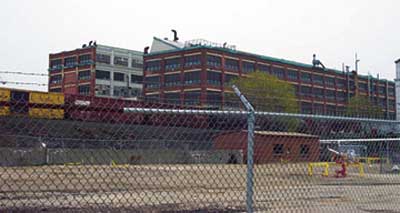
MAY 2005
Re-Use and Relocation (cover)
Mass. Finds Mutual Benefits in Redevelopment
A Brownfield in
Pittsfield Rises Again
Vermont Finds Good Fortune Near State Lines
Jewels and Barges Dot Rhode Island Project Landscape
Whose Side
Are You On?
LNG and Water On
Hold in Maine
'Fair and Workable'
Request Information

A Brownfield in
Pittsfield Rises Again
Pittsfield Rises Again
"A river is more than an amenity, it is a treasure."
— U.S. Supreme Court Justice Oliver Wendell Holmes

|

|
| The decades-long process of remediating GE's complex in Pittsfield, Mass., has reached the stage where redevelopment can now occur. |
Justice Holmes was ruling in a case pitting New Jersey vs. New York when he made the above statement in 1931. But he could just as well have been talking about his hometown of Pittsfield, Mass., where the treasure that is the Housatonic River is at the center of one of the nation's longest-running brownfield projects.
At the center of the project are General Electric, the EPA and the Pittsfield Economic Development Authority (PEDA). At press time, GE was set to turn over a 52-acre (21-hectare) parcel to PEDA for further redevelopment as the William Stanley Business Park after many years of legal wrangling, demolition and remediation (Inventor Stanley was the first to show how transformers could help light streets, in 1886.)
Bill Hines, chairman of PEDA, says the project is a model for how to develop a brownfield site in cooperation with the EPA, as opposed to turning it into a Superfund site.
By agreement with GE, industrial and office is the main target sector for re-use of the property, which will see an initial construction of six buildings. As Hines explains, "GE does not want to have to deal with this once they turn it over to us." He adds that interest in the site has come primarily from plastics, medical device and biotech companies, and notes the high proportion of tooling and molding expertise in the area, largely a result of the GE Advanced Plastics division's legacy. The company first occupied the overall property in 1903, and has manufactured transformers, ordnance and plastics there. Transformer production at the site ceased in 1985.
The legacy of some of those operations was PCBs in the ground and in the Housatonic River over five decades across a 254-acre (103-hectare) area. GE first acknowledged the source of the contamination in 1981. A Consent Decree among the company and state and federal regulators was approved by a federal judge in 2000, allowing the cleanup to begin. Cleanup has been gradual, and its costs, shared by the company and the federal government, are expected to reach the hundreds of millions of dollars.
"GE has been involved with this project from the concept stages and has been actively implementing the remediation of the land and the demolition of 1.8 million square feet [167,220 sq. m.] of old buildings since the approval of the Consent Decree in 2000," says Mike Carroll, GE's site manager for environmental remediation. He says GE is funding $45 million of the redevelopment costs for the business park, and that its overall obligations as a result of the Consent Decree will mount to some $200 million.
Remedial evaluations were completed in 2002, followed by the completion of demolition of one cluster of buildings in 2004. The EPA's March 2005 certification of the remedial work's completion is what led to the first land transfer to PEDA this spring.
Asked what plans might be in place for the rest of the 10 "removal action areas" outlined in the Consent Decree, Carroll says "GE is presently maintaining the balance of its facilities for the GE Advanced Materials business, a component of General Dynamics, and its continuing obligations under the Consent Decree."
Carroll says it took a long time to "investigate, evaluate and implement remedial actions," but the size and complexity of the site were the primary causes. He points to the patient and longstanding collaboration of GE, EPA, MADEP, the City of Pittsfield, and the Pittsfield Economic Development Authority.
"The parties have put aside the past disagreements concerning the site's designation," he says. "It took a lot of creativity and positive energy by many of the stakeholders to reach the compromises necessary to make this project a reality. It is an excellent example of people with varying interests working together towards a common goal."
That common goal has been the parcel's best use. Asked what can be drawn from the project in best practices, Carroll says, "Keep the lines of communication open and honest despite the differences of opinion that occasionally arise."